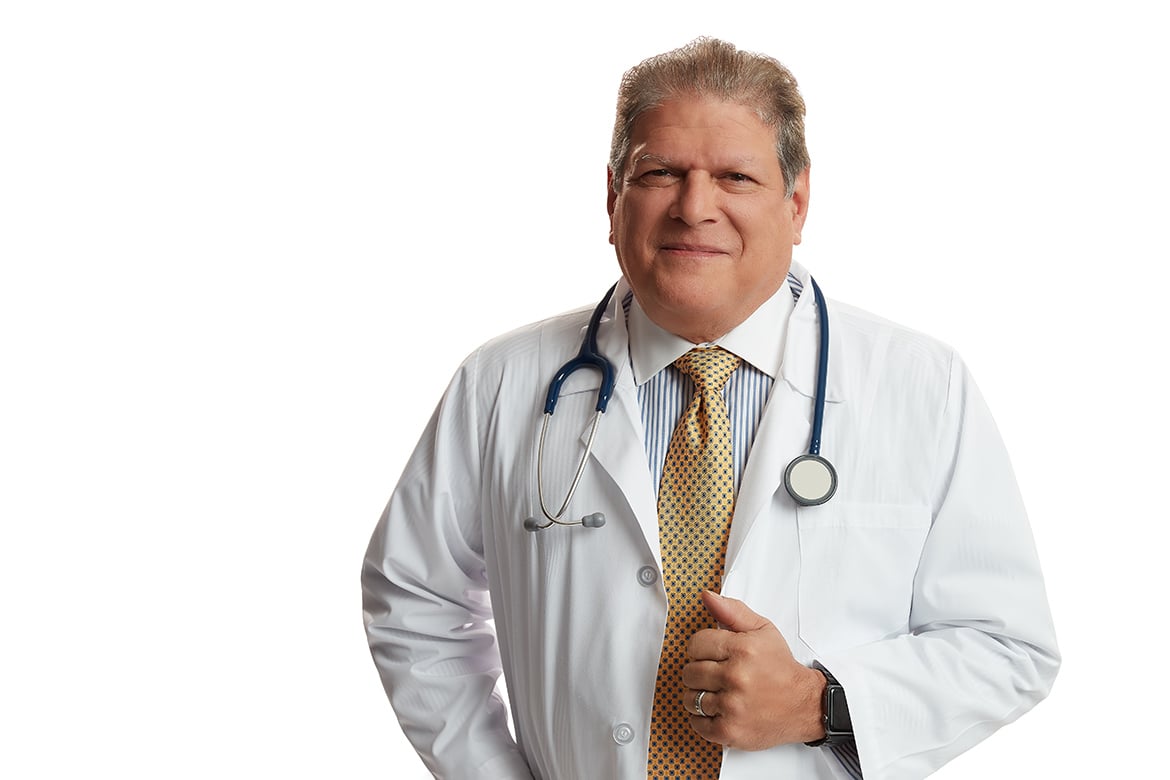Since childhood, AMA member Sam Arce, MD, wanted to be a doctor. He was so sure of it that he didn’t consider anything else as an alternative. He was going to make it happen. But unlike many of his medical school classmates, Dr. Arce was the first one in his family to become a physician.
“I went to medical school at a time when not a lot of Hispanic people were going into med school and not necessarily a lot of Hispanic doctors,” said Dr. Arce, a family physician in Queens, New York, and the National Hispanic Medical Association (NHMA) representative of the AMA Minority Affairs Section (AMA-MAS) Governing Council. While he was born in Brooklyn, both his parents are from Puerto Rico.
“I came from a community in Queens that was predominantly of color. I am bilingual in Spanish and English, so I became two physicians in one,” he said. “My pathway seemed to go in the direction where I was a physician and at the same time wanted to advocate for my community and get involved in other things.”
In an interview with the AMA, Dr. Arce discussed being a Hispanic physician leader, the importance of patients having doctors who look like them, and how he advocates for his community.
AMA: How did it feel going into medical school at a time when there weren’t many Hispanic students or physicians?
Dr. Arce: I went to school in Puerto Rico, so I did see a lot of Hispanics there. But that was a subset of the entire cosmos. And when I went to some interviews for jobs after residency, it showed through that. I was being interviewed by people who didn’t look like me or maybe even act like me. But I was at the right place at the right time because I was bilingual, I was an American graduate and that’s what they were looking for.
While I did not get my first choice for a contract, it wound up being the best choice because it allowed me to have more hands-on experiences and be able to be supervised, but at the same time be able to do more—touch more people and learn more in communities.
AMA: You have held many leadership positions throughout your career. How did that begin?
Dr. Arce: It started with my getting involved more locally, and then rose in an international situation. I started out locally as the president of the Spanish American Medical Dental Society of New York, which was the largest of its kind in the country. I served for a number of years and from there was invited to lead all the Hispanic medical societies across the country for the National Hispanic Medical Association, representing about 55,000 colleagues.
Then I became chair of NHMA and from there I also served as the first and only primary care minority physician on the national board for the American Diabetes Association. I’ve also been blessed to be invited to the White House several times to be a speaker. It doesn’t matter what political party it is—it’s an honor to even be asked. I also became the main representative from NHMA to the AMA Minority Affairs Section Governing Council.
AMA: How have these leadership positions helped you advocate for patients?
Dr. Arce: We’ve been able to see the perspective from other minoritized and marginalized groups across the country, specifically in my case Hispanic individuals, and the idiosyncrasies that Hispanic patients may present and how to go about making health care more equitable and reaching more people.
I’ve been blessed to be in that situation where I can contribute something. Anything you do outside of medicine will cost you something, but I didn’t come from a big background, so I was used to that. I’ve been blessed because my profession has allowed me to prosper, and you have to sit back and say: What can I do to give back? Too many of my colleagues do not do that, so we don’t get enough representation.
One of the honors that I had was to be chosen as an honoree for the National Puerto Rican Day parade, which is the largest of its kind in the country. To me, that was an awesome honor because it’s your own who like you.
AMA: What are your plans after completing your role in the AMA-MAS Governing Council?
Dr. Arce: I am also involved in multiple other things. I am president of the Queens chapter of the American Academy of Family Physicians. Queens, which is where I’m at in New York, is the largest, most diversified county in all of America. I have served there for several years and continue to serve as president of that chapter. That keeps me busy.
I am also involved in a lot of other boards as an adviser for things such as inflammatory bowel disease. It is affecting our communities, but it is not being brought out much. More and more we are seeing Black and Hispanic individuals develop inflammatory bowel disease, so we are looking to retrain colleagues because as we were taught [that] you would not expect to see that in the communities that we serve. But over the last few years, it’s been going up and up and up, so we are trying to bring awareness to that.
AMA: How do you further reach and inspire people from historically excluded racial and ethnic groups to enter medicine?
Dr. Arce: At the AMA, what we have done in the past is that we would go out into communities where we were having our meetings and be able to reach out to local students to try to get them to also be stimulated to go into medicine. The Doctors Back to School™ program has been a nice program and one of our goals is to get more involvement from our communities in medicine. We now know that, for instance, there’s a huge shortage of physicians who are from marginalized and minoritized groups.
When you look at the Hispanic community, we may have about 20% of the population, yet we only have about 6% physicians, so there is a disparity there. And the reasoning for that is multifaceted. When we look at Black males in medicine, the number has considerably gone down and continues to go down. We have to do something to turn that around because—again—if you can establish relationships and look like the communities that you serve, you do a better job and have better outcomes.
AMA: As a Hispanic physician leader, does that representation help inspire others to follow in your footsteps?
Dr. Arce: I'm sure that that will happen. For example, my sister has three sons and there were no physicians prior to my becoming a physician. I'm not even saying that it's due to the fact that I am a physician, but all three of my sister’s sons are now physicians.
If I was able to even put a small drop into that, that was worth it for me. But I don’t want to just limit it to that family situation. Similarly, I get students coming to the office and I try to encourage them to enter medicine. Some of them are going to go into other areas of medicine, just not as a physician. But they have the ability, they have the talent to become a physician and to make it.
AMA: Do you participate in mentorship opportunities for Hispanic medical students and residents?
Dr. Arce: I am on faculty at a couple of the medical schools here in New York and I do get students coming through. One of the goals that I try to accomplish is to look at the broader picture. There are very few Hispanic students here, so what I tried to do when I get students coming through is to also teach them a little bit of Spanish that they can use.
You don’t have to be bilingual. You don’t have to be very fluent, but you can know certain things that make you a better individual to begin with. So, I will try to teach some “medical Spanish” to medical students.
A lot of times, I’ll get students who want to shadow me to see what I do and try to get a liking for what is happening in the office. And those students I try to encourage also to go into medicine, because many of them are still in high school and don’t know what they want to do yet.
As I was growing up, I got a lot of discouragement from the professionals in the education system telling me that maybe I should go into something else and not into medicine. So, sometimes that is a hindrance for people. We grow up thinking that some professions are for certain groups and not for others.
I’m a firm believer that everyone does have the ability to go into medicine. I still enjoy what I do. I still get up in the morning and want to go to work. It’s about what you do to give back to a profession that is giving you a lot.
AMA: What is your hope for Hispanic people and other historically excluded racial and ethnic groups in medicine?
Dr. Arce: My hope across the board is to increase the number of physicians from minoritized and marginalized communities that enter medicine and stay in medicine, and to be able to get so involved that you sit at the table where decisions are being made. If we don’t sit at the table, we don’t get our voices heard. If you’re not at the table, you can’t influence the decision-making.
It doesn’t matter if you’re Black, Hispanic, Asian or Native American, increasing the numbers is huge. It’s about creating more physicians who look like the communities that we serve.




